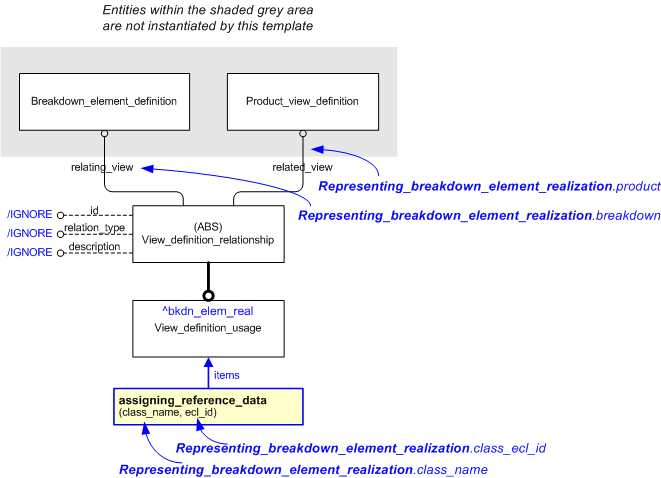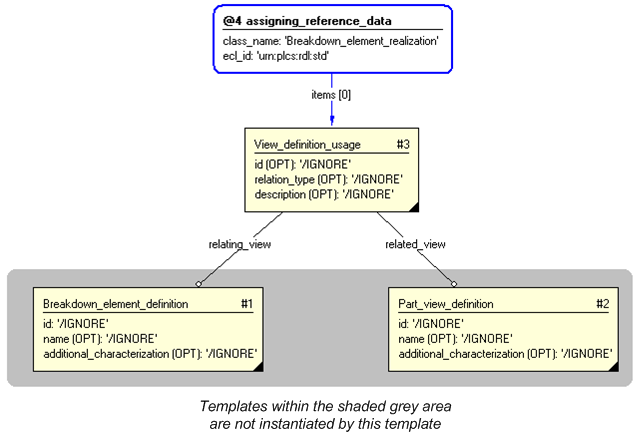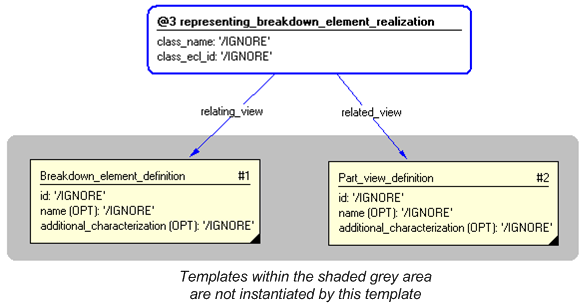Template:— representing_breakdown_element_realization (rep_bkdn_elem_real)
Capability:representing_breakdown_structure |
Date: 2008/02/29 18:15:49
Revision: 1.2
|
This section specifies the template representing_breakdown_element_realization.
NOTE
The template has been defined in the context of the capability
representing_breakdown_structure
which provides an overall description of the
relevant parts of the ISO 10303-239 information model and a description
of related templates.
NOTE
An explanation of a template and the associated instantiation path is
provided in the
Template overview
section.
This template describes how to represent a realization of a Breakdown element.
NOTE
This template deprecates the usage of Breakdown_element_realization.
The EXPRESS-G diagram in
Figure
1
shows the templates and EXPRESS entities that are required
to represent the template
"representing_breakdown_element_realization".
The text highlighted in blue shows the template parameters.
Figure 1 — An EXPRESS-G representation of the Information model for representing_breakdown_element_realization
The graphic for the template to be used in other EXPRESS-G diagrams
is shown in Figure
2
below.
Figure 2 — The graphical representation of the representing_breakdown_element_realization template
The following input parameters are defined for this template:
The name of the
External_class that determines the role of the
breakdown element realization.
The following classes and their sub-classes can be used:
The following reference parameters are defined for this template:
Allow the
View_definition_usage
entity instantiated in this path to be referenced when this template is used.
%^target = $representing_breakdown_element_realization.bkdn_elem_real%
The instantiation path shown below specifies the entities that are to be
instantiated by the template.
A description of templates and the syntax for the instantiation path is
provided in the
Templates Help/Information section.
The following entities are instantiated with attributes as specified:
The instance diagram in Figure
3
shows an example of the EXPRESS entities and templates that are instantiated by the template:
/representing_breakdown_element_realization(breakdown='#1', product='#2', class_name='Breakdown_element_realization', ecl_id='urn:plcs:rdl:std')/
(an illustration of the consolidated representing_breakdown_element_realization template is shown in
Figure
4 below.)
Figure 3 — Entities instantiated by representing_breakdown_element_realization template
The instance model in STEP ASCII exchange file format (ISO 10303 Part
21 syntax) is:
#1 = BREAKDOWN_ELEMENT_DEFINITION('/IGNORE','/IGNORE','/IGNORE',$,(),$);
#2 = PART_VIEW_DEFINITION('/IGNORE','/IGNORE','/IGNORE',$,(),$);
#3 = VIEW_DEFINITION_USAGE('/IGNORE','/IGNORE','/IGNORE',#1,#2);
#5 = CLASSIFICATION_ASSIGNMENT(#6,(#3),'/IGNORE');
#6 = EXTERNAL_CLASS('/NULL','Breakdown_element_realization','/IGNORE',#7);
#7 = EXTERNAL_CLASS_LIBRARY('urn:plcs:rdl:std','/IGNORE');
The instance diagram in
Figure
4
shows the graphic symbol for the template that is to be
used in other instance diagrams. The example template is:
/representing_breakdown_element_realization(breakdown='#1', product='#2', class_name='Breakdown_element_realization', ecl_id='urn:plcs:rdl:std')/
Figure 4 — Instantiation of representing_breakdown_element_realization template
Characterizations
No common characterizations of the template
representing_breakdown_element_realization
have been identified. However, the ISO 10303-239 EXPRESS model
may enable other assignments to the entities instantiated by the template.




